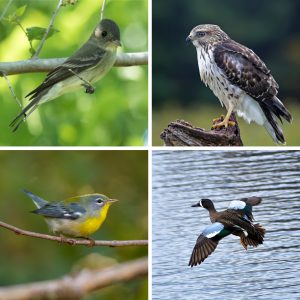Virginia Incidental Take Regulations Will Affect Many Industries… and That’s Not by Accident

Migratory bird species in Virginia include (clockwise from top left) Eastern wood peewee, broad-winged hawk, blue-winged teal, and northern parula.
The Virginia Department of Wildlife Resources (DWR) has announced groundbreaking new regulations to protect migratory birds from harm, filling a regulatory gap created by pullback of federal regulations regarding migratory birds. The proposed regulation will affect nearly every part of the development industry in Virginia and will require new permits for construction activities. Wetland Studies and Solutions, Inc. (WSSI) has broken down this important change for our Field Notes readers.
Why is Virginia Considering these New Regulations?
As noted in our May 2018 and February 2021 Field Notes articles, the Trump Administration limited the need for take permits for migratory birds only to instances where the action was intended to “take” migratory birds, i.e., purposeful taking, capturing, or killing these species, their nests, or their eggs. Under this interpretation, other actions, where the intent was not to “take” these species but could result in their “incidental take” (e.g., clearing of trees which could damage nests, construction of wind turbines that may kill birds, etc.), no longer need an incidental take permit under the federal Migratory Bird Treaty Act (MBTA). To continue protecting these species, DWR announced in early 2020 that they would be considering regulations regarding migratory birds.
How Could This Affect My Projects?
The proposed regulation mandates that incidental take¹ permits for migratory birds be obtained prior to conducting certain Regulated Activities, defined in the proposed language as “…a new construction or development activity or the expansion of an activity beyond the original or existing footprint of the activity for which [DWR] has adopted a sector-specific plan that identifies best management practices designed to avoid or minimize incidental take of regulated bird species and/or habitats or, in certain circumstances, identifies the need for an individual incidental take permit.”
The following sectors are covered under the proposed rule:
- Commercial projects
- Industrial projects
- Oil, gas, and wastewater disposal pits
- Methane or other gas burner pipes
- Communications towers
- Electric transmission and distribution lines
- Wind and solar energy projects
- Transportation projects
Agricultural and silvicultural activities are exempted from the rule, and residential projects are not mentioned as either a regulated sector or exempt.
The proposed regulations mandate that either general or individual permits be obtained for regulated activities. Thresholds for these permits are not outlined in the proposed regulations but will be determined by the Board of Wildlife Resources at some point following adoption of the regulation.
Additional Details
While the proposed regulations provide an overall framework for the program and permits, specifics are lacking. Thresholds for the different permits (i.e., general vs. individual) will be established by the Board in the future, and it is not clear at this time as to what the thresholds will entail. Some permits may also require permittees to monitor impacts to regulated bird species as a result of the permitted activities.
The proposed regulations outline a specific timeframe for determining the completeness of an application (45 days) and allow an additional 90 days for review of a general permit and 120 days for review of an individual permit.
Residential development is not specifically noted as a regulated, sector-specific activity, but it is also not noted as an activity exempted from the proposed regulations. We recommend that those in the homebuilding industry provide comment and seek clarification regarding regulation coverage for their industry. Anyone wishing to provide comment may do so here until February 22, 2021.
WSSI Can Help
WSSI staff will be following this issue closely and will provide more updates as they become available. If you wish to discuss these proposed regulations, and how they may affect your projects, please contact Ben Rosner, Bob Kerr, Mark Headly, or Suzie Richert.
1 Per the proposed regulation, “Take” means to harass, harm, pursue, hunt, shoot, wound, kill, capture, trap, collect, possess, destroy, disturb, or to attempt to engage in any such conduct, or any activity that significantly or permanently impedes breeding, foraging, resting, or other normal avian behaviors conducted during the annual life cycle, obstructs the use of or destroys or degrades regulated habitats, or reduces reproductive success or survival rates of regulated bird species, and includes any incidental take. Take excludes deliberate harassment measures carried out for the sole purpose of deterring regulated bird species from the site of a regulated activity only when all other options to avoid, minimize, and/or mitigate incidental take have been considered and judged ineffective by the department.
